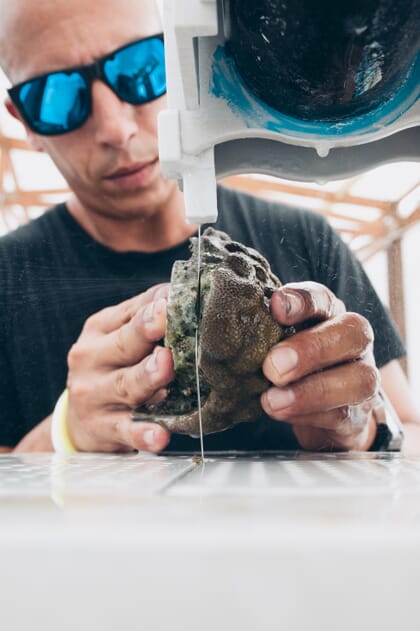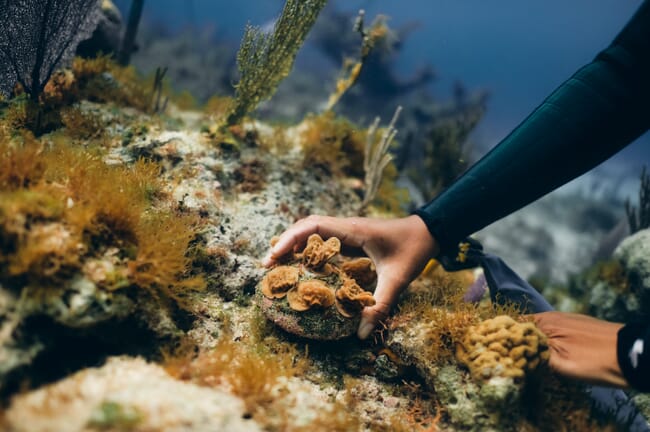
© Harry Lee/Coral Vita
One of Simon Dixon’s earliest memories is listening to the dulcet tones of David Attenborough as bright and brilliant images of coral reefs and their many inhabitants flickered across the TV screen. For many this remains simply a fond memory, but for Dixon it grew into a passion for marine biology and conservation and, eventually, into a career restoring degraded coral reefs with Coral Vita.
Based in Grand Bahama, Coral Vita uses pioneering land-based coral farming techniques to accelerate the process of reef restoration. As is the case with so many reefs around the world, the impacts of global climate change, tourism, and invasive species have devastated the corals of the Bahamas, which act as vital ecosystem engineers. This degradation in turn has severe knock-on effects for the species which inhabit the reefs.
“We are seeing a huge drop off in keystone species, such as your Acropora palmata, A. cervicornis, and A. prolifera, which used to be present in huge numbers within this region and play a crucial role in mitigating wave action and erosion to these islands,” Dixon explains.
And it is exactly this mass degradation of coral reefs that Coral Vita is attempting to reverse, as daunting a task as that may seem.
Aquaculture in action
In order to restore the reefs, Coral Vita is taking a unique approach, mixing natural processes with scientific manipulation. Through a technique called microfragmentation, Dixon and his team cultivate corals at their land-based farm in the Bahamas before transplanting them back into the reef where they can continue to grow and thrive.
The real beauty of Coral Vita’s approach to reef restoration is its simplicity – taking a naturally occurring process and harnessing it for the benefit of many.
“Imagine a small piece of a digitate coral breaks off from the parent colony. That fragment will fall down and settle onto the reef, wedging itself into a gap in the rock. As long as that fragment receives enough light and has the right conditions, it will start to encrust and grow over the place where it has fallen, eventually creating a genetically identical copy of the parent,” Dixon explains.

© Harry Lee/Coral Vita
This process, not dissimilar to the planting of a terrestrial plant cutting, forms the basis of Coral Vita’s operation. However, corals can grow very slowly - ranging from a few millimetres to almost 10 centimetres a year - and, for reef restoration, time is of the essence.
Taking a large parent colony, Dixon and his team “microfragment” it, cutting it up into very small pieces which are then placed on an artificial substrate for them to grow on at the land-based farm. By cutting the parent colony into such small fragments, the coral exhibits a natural response whereby it will grow at an accelerated initial rate to try and establish itself before it is killed or dislodged from its settling place. The corals can then be moved through the farming process until they reach a state where they are ready to be transplanted back out onto the reef.
Of course, different species require different conditions for optimal growth, and have different ideal sizes for transplantation, and this is all considered as part of Coral Vita’s farming process.
“We're essentially taking a part of nature and manipulating it within our systems to try and get faster growth initially,” Dixon comments.
Whilst this method of restoration is enough to temporarily stabilise coral populations, without rapid evolution or genetic manipulation, increasingly adverse environmental conditions, such as increasing ocean temperatures, will cause the corals to die on the reefs just as their predecessors have done. This one of Coral Vita’s key challenges – the development of a protocol for the selection and breeding of thermo-tolerant corals.

© Simon Dixon/Coral Vita
“The goal is not just to grow corals in the farm as best we can. The goal is to grow corals in the farm as best we can and make sure they survive on the reef. That's the real key - they have to survive on the reef. It's no good if we can just grow them really quickly in the farm, and as soon as you put them out on the reef, they all die. It's a waste of everyone's time,” Dixon explains.
“We're looking through genetic tracking of corals using various artificial intelligence systems that we've developed to help us find out which ones are more susceptible to predation, disease, and fluctuations in our system. When we identify the ones that are more tolerant and robust then we can start experimenting on these particular genotypes, looking at how they interact with thermo-tolerant experiments, and then start to pick corals which we can start selectively breeding through sexual reproduction rather than asexual reproduction,” he adds.
Why it all matters
As Dixon mentions, the health of a coral reef has complex and diverse knock-on impacts for both the wider marine ecosystem and for the people who live where the reefs are located. A healthy reef is so much more than a collection of colourful fish. These ecological wonders act as nursery habitats for a plethora of species, and are connected to the stability of marine populations well beyond the geographical limitations of the reef itself. They help to protect coastlines from tidal erosion and provide an income to communities who rely on tourism.
“By supporting the reefs, you're developing an economy on this tiny island which, at the moment, is not great. You're developing and you're building those opportunities for people to come here and spend their money, and I firmly believe that it has a cascading effect. If we can start moving forward in some of these aspects and get people to care a little more and get people to be more invested in these things, you're going to start to see the knock-on procedures happening very, very quickly.”

A coral is transplanted back out onto the reef © Nicholas von Albdhyll/Coral Vita
However, far from being solely concerned with the state of the reefs in Grand Bahama, Dixon emphasises his belief that a wider scope is needed if we are to stand a chance at successful marine conservation.
“It's very easy for me to sit here and say that my main goal is to have a thriving reef. But I think we're well past the point now where we can say 'my doorstep is doing really well, how's your doorstep doing?' It doesn't work like that anymore. We need to talk about it as a global collective. We need to be developing techniques that are applicable all over the world,” he explains.
Looking to the future
Whilst Dixon states that he cannot speak for the goals of Coral Vita’s founders, he goes on to say that, personally, he wants to see the organisation’s operations expand into multiple locations around the world, and for the restoration technology to continue progressing. There is much scope, he says, for knowledge sharing within the industry.
“I would love for us to be really forging ahead with more resilient corals, looking at genetics, looking at spawning and sexual reproduction as a viable way to increase the amount of coral going out into the reefs. But, more than anything else, what I'd really hope is that we will be able to advance restoration in a really meaningful way over that time, using the model that we've put in place,” he reflects.
“We can fix this problem, so let’s do it. Whether or not it puts me out of a job, let’s just do it,” he concludes.




